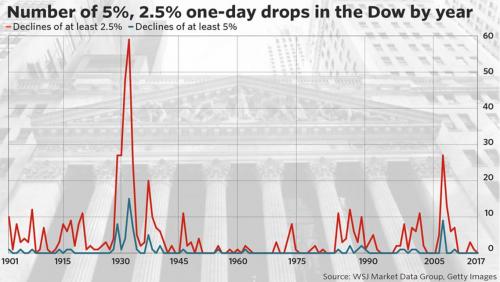A correction leading to a downturn is likely before serious
issues are resolved, such as:
Central Banks are in
a Blind Alley
Central banks can not readily afford to be even more
accommodating than they already are towards any market downturns. Even without doing anything much they are reneging
on their overdue expectations to withdraw liquidity and tighten rates. The main support they can offer is confidence
in their operations but this confidence will not last for long in the face of ineffective
action during a market downturn.
Insanely low
Volatility
The market has become a reflection of algo driven automated
trading, relying on mean reverting methods with an emphasis to dampening
volatility.
This is not a normal state.
Never before has the vix been so low, so much for so long. This is for both realised and implied or
anticipated volatility. This is indicative
of a central bank controlled and manipulated market.
Politics:
Debt ceiling debate,
Health care fiasco,
Tax reform,
Intrigue of the investigations behind the USPTO
A crisis in confidence in the lack of action in Washington
Unfunded pension liabilities
Instability in relations with Russia
The war drums beating for North Korea.
Why the arguments in Support
of the Bullish Case for the Market are flawed
Ultimately the valid warning signs of an over extended
market are being turned round to suggest that they represent a new area of
growth and stability. This flawed
argument is then backed by a unrealistic faith in central banks to overlook the
dilemmas coming crisis central bank policy is entering into.
1. Volatility
There are arguments that suggest the low Volatility of the
market is not a danger sign, but represent a new era of growth and
stability. This is a naive view. There is ample evidence to show that the
Volatility is dampened by Central bank actions and liquidity. Therefore, to say the cause is the natural
wellsprings of economic growth and that therefore the real cause (Central bank
liquidity) can be withdrawn is a bad trick and ought to fool no one.
Its like eating a obese man doing a days exercise and
claiming that the weight increase is muscle and the result of a new era of
fitness.
In fact, volatility is typically low when financial asset
classes are at their peak, across the board.
Low Volatility creates a market that is over leveraged,
based on expectations of continued low volatility. Therefore Low Volatility is a destabilising
influence in the event of a correction.
These investments in assets linked to Low Volatility runs in hundreds of
billions and all need to be deleveraged in a short time, in a time of limited
liquidity.
2. Private Sector
Funding.
Signs are the private Sector is investing more and hence the
Central banks can withdraw liquidity.
In fact, private sector borrowings are fantastically high,
as is leverage and borrowings in the market (based on the premise of low
Volatility continuing)
3. Central Banks
The argument is that with economic growth, reflation and private
sector funding that the central banks can keep to expectations to with draw
liquidity and tighten rates. These premises
are flawed example of circular reasoning
because they the premises are ultimately a result of central bank action in
first place

Comments
Post a Comment